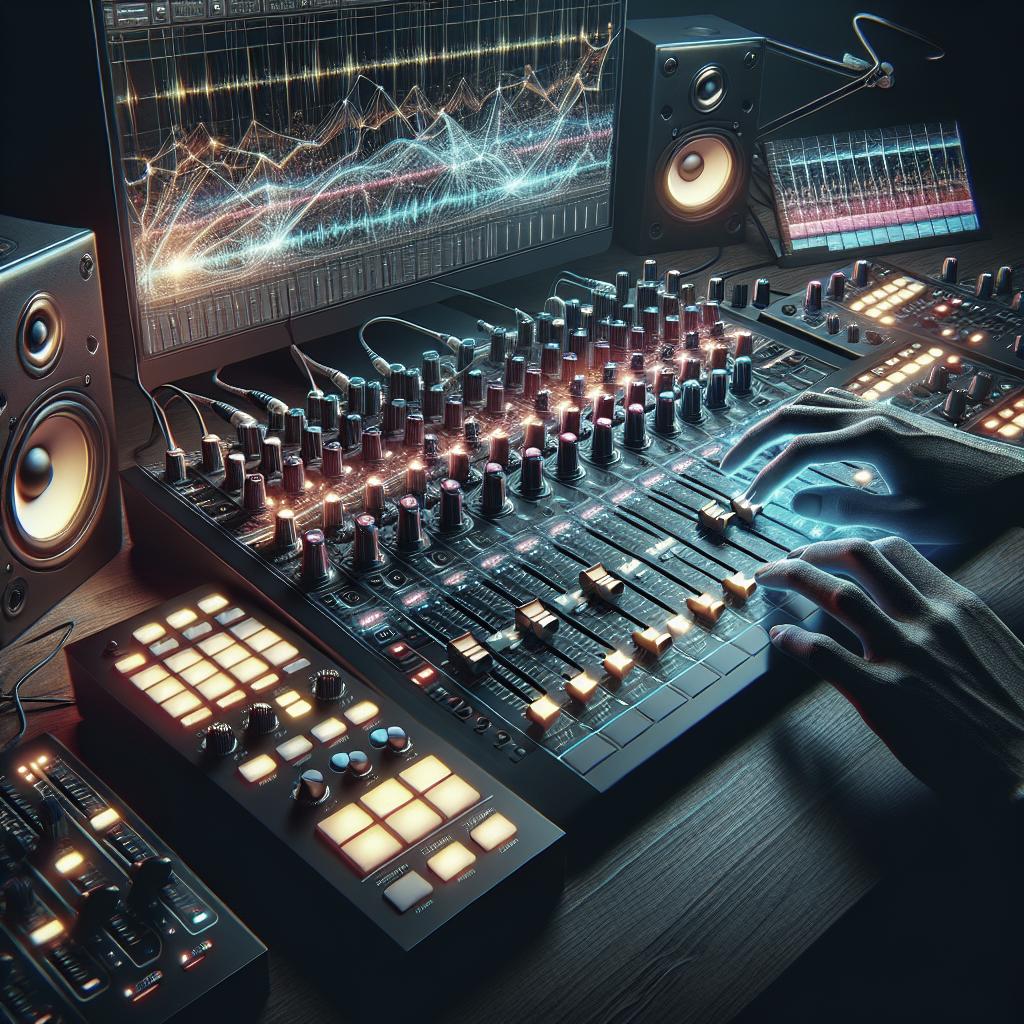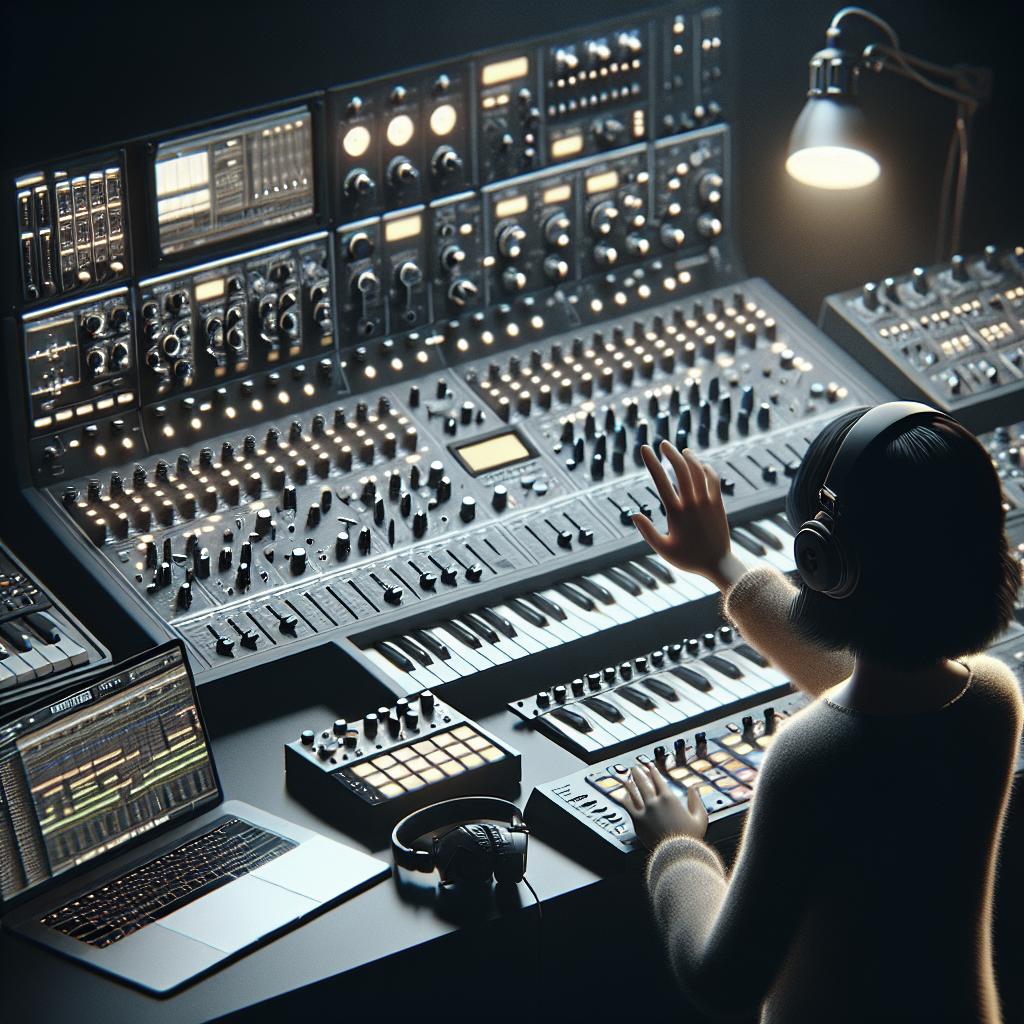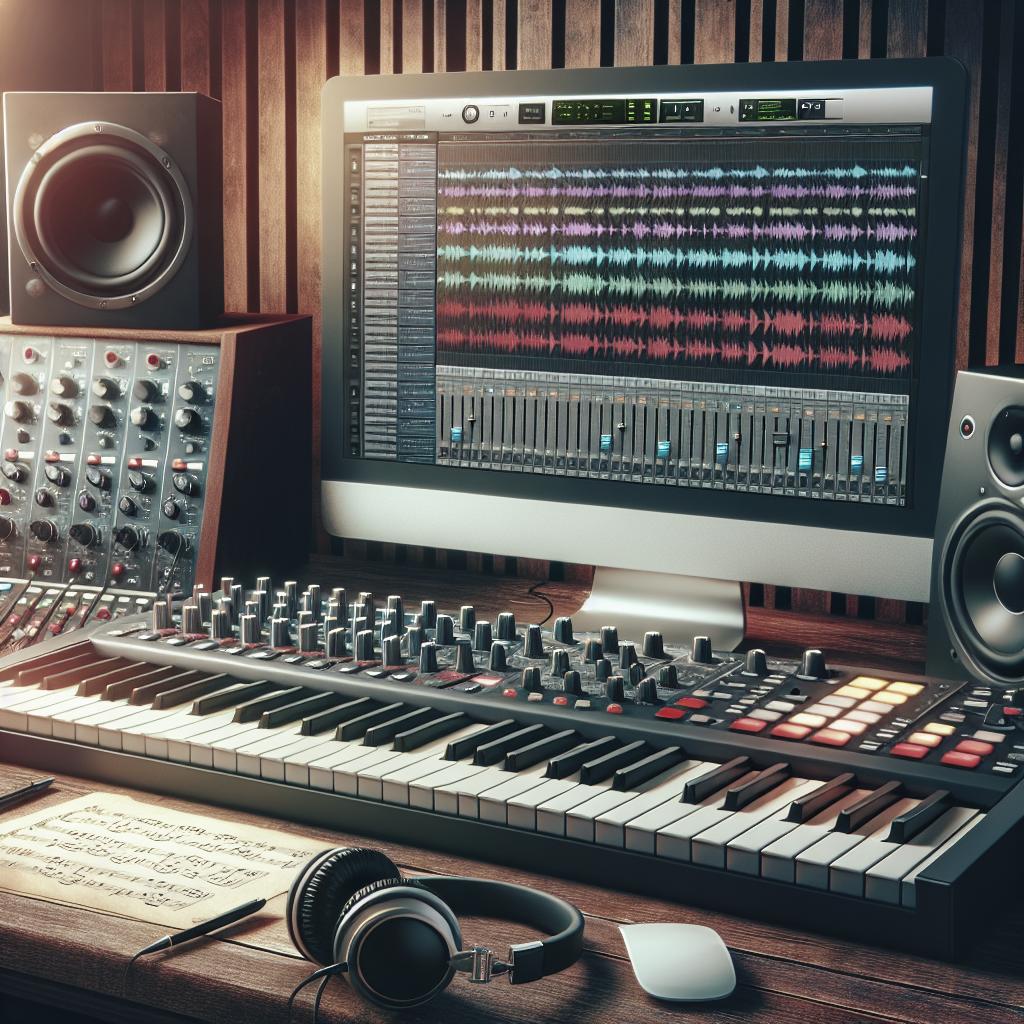<> Mixing electronic music is both an art and a science. It’s the process that brings together different elements of your track into a cohesive, polished final product. Whether you’re just starting out or looking to refine your skills, understanding the intricacies of mixing can significantly improve the quality of your music. In this guide, we’ll cover everything from sound design and automation to EQ techniques and using reference tracks. Each step is designed to help you build a clear, balanced mix that translates well across all playback systems. So let’s dive in and explore the crucial elements of mixing electronic music. —
1. The mix starts before choosing your first sound!
Before laying down your first beat or synth line, it’s essential to have a vision for your track. This includes understanding the genre, tempo, and overall vibe you want to achieve. By knowing what you aim to produce, you can make better choices when selecting sounds and samples. Think of this as setting the stage for everything that follows. Effective mixing begins at the composition and sound selection stage. Each sound should have its own space in the mix and should complement the other elements. This preliminary planning can save you a lot of time when you’re deep into the mixing process.
2. Sound design and sample selection
Sound design isn’t just about crafting the perfect snare or kick; it’s about creating sounds that fit well together. Use synthesizers and effects to shape your sounds, ensuring they occupy distinct frequencies. This will help avoid frequency clashes that can muddy your mix. Sample selection is equally crucial. High-quality samples can make a world of difference. Always opt for samples that have already been processed to some extent; it will save you a ton of time during mixing. Remember, great mixes are built on great sounds.
3. Tune your drums
Tuning your drums to match the key of your song can have a significant impact. It ensures that each drum hit contributes harmonically to the track. This is especially important for elements like kicks and toms, which can have strong tonal characteristics. You can use pitch-shifting plugins to adjust the tuning of your drums. Some drum machines and samplers also allow you to fine-tune each element. Even small adjustments can create a more unified and professional-sounding mix.
4. Use automation
Automation allows you to add dynamic changes to your track, keeping it interesting from start to finish. You can automate anything from volume and panning to more complex parameters like filter cutoff and reverb send levels. To get started, identify the areas where your track could use more movement or variation. Then, create automation lanes and draw in the changes. Automation helps create a sense of evolution and progression in your music, making it more engaging for listeners.
5. Cut EQ rather than boost
It’s often better to cut frequencies than to boost them. Boosting can add unnecessary gain and cause clipping. Cutting, on the other hand, helps you remove unwanted frequencies and clean up your mix without adding extra volume. When EQing, focus on removing muddiness and any frequencies that clash with other elements. A common approach is to use a low-cut filter to remove sub-bass frequencies from non-bass instruments, helping to clear up your low end.
6. Use distortion as EQ
Distortion isn’t just for adding grit to your sounds; it can also be used as a form of EQ. Subtle distortion can enhance harmonics, making sounds more present and cutting through the mix better. Start with gentle distortion on elements like basslines or synth leads. Listen to how the added harmonics affect the sound and its position in the mix. Be careful not to overdo it, as too much distortion can lead to a harsh, unpleasant mix.
7. Starting fader levels
Set your fader levels thoughtfully to ensure a balanced mix. A good starting point is to keep the kick and snare around -6 dB. Other elements can then be adjusted relative to these, often falling between -18 dB and -8 dB. Gradually bring in each element while ensuring the mix remains balanced. This approach helps maintain headroom and avoids clipping, making the mastering process smoother.
8. Check the mix on different speakers/ headphones
Your mix might sound amazing on your studio monitors but fall apart on other playback systems. Always check your mix on various speakers and headphones. It helps ensure that your track translates well everywhere, from earphones to car audio systems. Different devices have unique frequency responses, which can reveal issues in your mix. Take the time to make adjustments based on what you hear on each system.
9. Check the mix at different volumes
Listening at various volumes can spotlight different elements of your mix. Low volumes help you hear the balance and tonal relationships, while high volumes can reveal issues with dynamics and harsh frequencies. Ensure your mix sounds balanced and enjoyable at any volume. If something sticks out or gets lost at either extreme, adjust your levels and EQ accordingly.
10. Don’t mix with mastering effects on the master channel!
Applying mastering effects like compressors and limiters on the master channel during the mixing stage can be misleading. It might make your mix sound better temporarily, but it masks issues that need to be addressed in the mix itself. Keep your master channel clean when mixing. Save the mastering effects for the mastering stage, where you can apply them more effectively.
11. Use parallel processing to “fatten” the sound
Parallel processing involves running a copy of the track through additional effects and blending it back with the original. This can add depth and richness without overwhelming the initial signal. Common uses for parallel processing include parallel compression, where heavy compression on a duplicate track is mixed subtly with the original, intensifying the sound without squashing its dynamics.
12. Check your mix in mono (or mix in mono completely)
Mixing in mono can help you identify phase issues and ensure balance. Elements that clash or disappear in mono usually indicate phase cancellation, which can weaken your mix in stereo. Regularly check your mix in mono to ensure everything remains clear and balanced. Some producers go as far as mixing in mono entirely before switching to stereo.
13. Treat mixing and mastering as the separate beasts they are
Mixing and mastering are distinct processes with different goals. Mixing is about adjusting individual elements to create a balanced track, while mastering focuses on finalizing the mix and ensuring it translates well across all listening environments. Approach each stage separately for the best results. Finish your mix before starting the mastering process.
14. Use side-chain compression
Side-chain compression is a technique where the level of one track influences the compression of another. It’s widely used in electronic music to make kick drums punch through basslines or other elements. Set up side-chain compression by routing the kick drum to the side-chain input of a compressor on the bass track. Adjust the settings to create the desired pumping effect, which can add energy and clarity to your mix.
15. Make any bass under 130Hz monophonic
Stereo bass can cause phase issues and make your low end sound unfocused. Convert any bass frequencies under 130Hz to mono to preserve power and clarity in your low end. Most DAWs have tools or plugins to sum bass frequencies to mono. Apply this in your mix to keep your low end clean and punchy.
16. Create a radio edit in the same DAW project
Radio edits often require shorter track lengths and more refined arrangements. Create your radio edit within the same project to ensure consistency with the original mix. Editing within the same project allows you to maintain the same mix settings and effects, ensuring a seamless transition between different versions of your track.
17. Make use of grouping and bussing
Grouping related tracks and using buses for shared effects can streamline your mixing process. It allows for more efficient level adjustments and uniform processing on similar elements. For example, group all your drum tracks and route them to a drum bus. Apply compression or EQ on the bus to affect all drums simultaneously, creating a more cohesive sound.
18. Keep a copy of your arrangement session before starting the mix down
It’s always wise to save a copy of your project before starting the mixdown. This way, you can easily revert to the original arrangement if needed. Having a backup provides a safety net, allowing you to experiment in the mix without fear of losing your initial work.
19. High-pass filter “almost” everything
High-pass filtering is an effective way to reduce low-frequency clutter. Apply a high-pass filter to most elements except the bass and kick to clean up your low end. This technique helps focus the low end on essential elements, preventing muddiness and improving overall clarity.
20. Use a reference track
Reference tracks are essential for maintaining perspective. Choose a professionally mixed and mastered track in a similar style and compare it to your mix. Pay attention to balance, EQ, and dynamics. Reference tracks provide a benchmark, helping you identify areas needing improvement.
21. Test and ask for feedback
Playing your mix for others and soliciting feedback can offer fresh perspectives. Different ears can catch things you might have missed. Ask for feedback from trusted sources like fellow producers or audio engineers. Use their input to refine your mix further.
22. Mix the next day
Fresh ears can make all the difference. Take breaks and return to your mix with a fresh perspective. Mixing the next day can help you notice issues you missed earlier. This practice prevents ear fatigue, allowing you to make more accurate decisions.
23. Bounce to audio
Bouncing MIDI tracks to audio can make your project easier to manage and improve DAW performance. It also solidifies your creative decisions, allowing you to focus solely on mixing. Once you’re satisfied with your MIDI arrangements, bounce them to audio to streamline your workflow.
24. Don’t over-compress everything
Over-compression can squash the dynamics and make your mix sound lifeless. Use compression judiciously, focusing on controlling dynamics rather than crushing them. Balance is key—apply compression only where necessary to maintain the energy of your track.
25. Use a spectrum analyser
A spectrum analyzer visualizes the frequency distribution in your mix, helping you identify problematic areas. It’s an invaluable tool for ensuring a balanced frequency spectrum. Use it to check for frequency imbalances and make informed EQ decisions.
26. Give your ears rest
Mixing can be tiring for your ears. Regular breaks help prevent ear fatigue and maintain objectivity. Take short breaks every hour and longer breaks throughout the day to keep your ears fresh and your judgment accurate.
27. Don’t keep going if it sounds great
If your mix sounds great, don’t overthink it. Over-tweaking can lead to ruining what’s already working well. Trust your instincts—knowing when to stop is as crucial as knowing how to mix.
28. Mix the kick and bass first
The kick and bass form the foundation of most electronic tracks. Start by mixing these elements to establish a solid low end. Get them to work well together before adding other elements. This approach ensures your mix has a strong, defined low end.
29. The less going on in the low end, the better
Clutter in the low end can ruin your mix. Keep the low end clear by minimizing the number of elements occupying this frequency range. Focus on the kick and bass, and high-pass filter other elements to create space and clarity.
30. Apply effects to auxiliary channels
Using auxiliary channels for effects like reverb and delay maintains consistency and saves CPU resources. Send multiple tracks to the same aux channel to share effects. This approach creates a cohesive sound and simplifies your mix session.
BONUS WORKFLOW TIPS:
1. Do the right things in the right order
Effective workflow is about prioritizing tasks. Start with sound selection and arrangement before diving into detailed mixing. Following a logical order streamlines the process, ensuring each stage builds on the previous one efficiently.
2. Assign keyboard shortcuts
Keyboard shortcuts can significantly speed up your workflow. Customize your DAW’s shortcuts for commonly used actions. This efficiency translates to more time for creative decisions and less time spent on manual tasks.
3. Take breaks often
Frequent breaks help maintain mental and auditory sharpness. Step away from your project to return with a clear mind and fresh ears. Regular breaks enhance productivity and ensure your mix decisions are accurate and thoughtful. —
Lessons Learned
| Step | Key Takeaway |
|---|---|
| The mix starts before choosing your first sound! | Plan your track’s direction to inform better sound and sample choices. |
| Sound design and sample selection | Craft and select complementary sounds for a cohesive mix. |
| Tune your drums | Harmonize your drums with your track’s key for unity. |
| Use automation | Create dynamic changes to keep your track engaging. |
| Cut EQ rather than boost | Clean-up frequencies to avoid adding unwanted gain. |
| Use distortion as EQ | Enhance harmonics for more presence in the mix. |
| Starting fader levels | Maintain headroom by setting initial levels thoughtfully. |
| Check the mix on different speakers/headphones | Ensure your mix translates well across all systems. |
| Check the mix at different volumes | Ensure your mix sounds balanced at any volume level. |
| Don’t mix with mastering effects on the master channel! | Keep the master channel clean until the mastering stage. |
| Use parallel processing to “fatten” the sound | Add depth without overwhelming the original signal. |
| Check your mix in mono (or mix in mono completely) | Identify phase issues and ensure balance. |
| Treat mixing and mastering as the separate beasts they are | Approach each stage with distinct strategies for best results. |
| Use side-chain compression | Create space and dynamics by using key tracks to influence compression. |
| Make any bass under 130Hz monophonic | Ensure a focused and powerful low end. |
| Create a radio edit in the same DAW project | Maintain consistency by editing within the same project. |
| Make use of grouping and bussing | Streamline your mix with efficient level adjustments and uniform processing. |
| Keep a copy of your arrangement session before starting the mix down | Preserve your work and allow for safe experimentation. |
| High-pass filter “almost” everything | Clear low-end clutter for a cleaner mix. |
| Use a reference track | Maintain perspective by comparing to a professional mix. |
| Test and ask for feedback | Gain fresh perspectives to refine your mix. |
| Mix the next day | Return with fresh ears for more accurate decisions. |
| Bounce to audio | Solidify decisions and improve DAW performance. |
| Don’t over-compress everything | Maintain dynamics by using compression judiciously. |
| Use a spectrum analyzer | Visualize and balance the frequency spectrum. |
| Give your ears rest | Prevent ear fatigue for better mix decisions. |
| Don’t keep going if it sounds great | Avoid over-tweaking a well-balanced mix. |
| Mix the kick and bass first | Establish a strong foundation for your track. |
| The less going on in the low end, the better | Minimize elements to maintain a clear low end. |
| Apply effects to auxiliary channels | Maintain consistency and save CPU resources. |
| BONUS TIP: Do the right things in the right order | Prioritize sound selection and arrangement before mixing. |
| BONUS TIP: Assign keyboard shortcuts | Increase efficiency by customizing shortcuts. |
| BONUS TIP: Take breaks often | Maintain sharpness and objectivity with regular breaks. |


